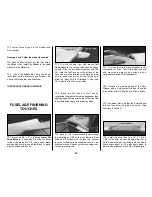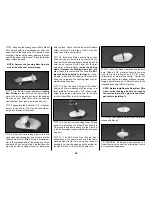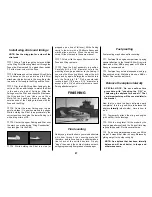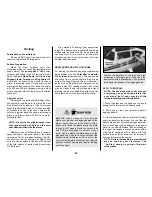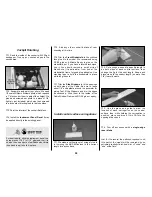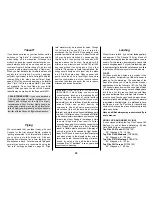
to slow down for landing. Moving the balance
aft
makes the model more agile, gives it a lighter
“feel” and often improves landing. In any case,
please start at the location we recommend
and do not at any time balance your model
outside the recommended range.
❏
2. With the wing attached to the fuselage, all
parts of the model installed (ready to fly) and an
empty
fuel tank, suppor t the model at the
balance point.
❏
3. Lift the model at the balance point. If the tail
drops when you lift, the model is “tail heavy” and
you must add weight
*
to the nose to balance. If the
nose drops, it is “nose heavy” and you must add
weight* to the tail to balance.
NOTE:
Nose weight
may be easily installed by using a spinner weight or
gluing lead weights into the engine compartment.
Tail weight may be added by using Great Planes
(GPMQ4485) “stick-on” lead weights and, later, if
the balance proves to be OK you can open the
fuse bottom and glue these in permanently.
*
If possible, attempt to balance the model by
changing the position of the receiver battery and
receiver first. If you are unable to obtain good
balance by doing so,
then
it will be necessary to
add weight to the nose or tail to achieve the
proper balance point.
Follow the battery charging procedures in your
radio instruction manual. You should
always
charge your transmitter and receiver batteries
the night before you go flying and at other times
as recommended by the radio manufacturer.
The best place to fly your R/C model is an AMA
(Academy of Model Aeronautics) chartered club
field. Ask your hobby shop dealer if there is such
a club in your area and join. Club fields are set
up for R/C flying and that makes your outing
safer and more enjoyable. The AMA also can tell
you the name of a club in your area. We
recommend that you join AMA and a local club
so you can have a safe place to fly and have
insurance to cover you in case of a flying
accident. (The AMA address is listed on page
3
of this instruction book).
If a club and flying site are not available,
you’ll need to find a large, grassy area at least 6
miles away from buildings, streets and other R/C
activities. A schoolyard may look inviting but it is
too close to people, power lines and possible
radio interference.
If you are not thoroughly familiar with the operation
of R/C models, ask an experienced modeler to
check your radio installation and control surface
set-up. Engine operation must also be checked
and the engine “broken-in” on the ground by
running at least two tanks of fuel through the
engine.
Follow the engine manufacturer’s
recommendations for break-in.
Check to make
sure all screws remain tight, that the hinges are
secure, and that the prop is on tight.
Make it a habit: Check the operation of your
radio
before
you fly,
every time
you fly. With the
transmitter antenna collapsed and the receiver
and transmitter on, you should be able to walk at
least 100 feet away from the model and still have
control. Have someone help you. Have them
stand by your model and, while you work the
controls, tell you what the various control
surfaces are doing.
Repeat this test
with the engine running
at
various speeds with an assistant holding the
model, using hand signals to show you what is
happening. If the control surfaces are not always
acting correctly,
do not fly!
Find and correct the
problem first.
NOTE: Failure to follow these safety
precautions may result in severe injury to
yourself and others.
Keep all engine fuel in a safe place, away
from high heat, sparks or flames, as fuel is very
flammable. Do not smoke near the engine or
fuel; and remember that the engine exhaust
gives off a great deal of deadly carbon
monoxide. Therefore,
do not run the engine in
a closed room or garage
.
Get help from an experienced pilot when
learning to operate engines.
Use safety glasses when starting or running
engines.
Do not run the engine in an area of loose
gravel or sand; as the propeller may throw such
material in your face or eyes.
Keep your face and body, as well as all
spectators, away from the plane of rotation of the
propeller as you start and run the engine.
Keep items such as these away from the
prop: loose clothing, shirt sleeves, ties, scarfs,
long hair or loose objects (pencils, screwdrivers)
that may fall out of shirt or jacket pockets into
the prop.
Engine safety precautions
Range check your radio
Ground check the model
Find a safe place to fly
Charge the batteries
PREFLIGHT
53
Summary of Contents for CESSNA 182 SKYLANE
Page 8: ...8 DIE CUT PATTERNS ...





